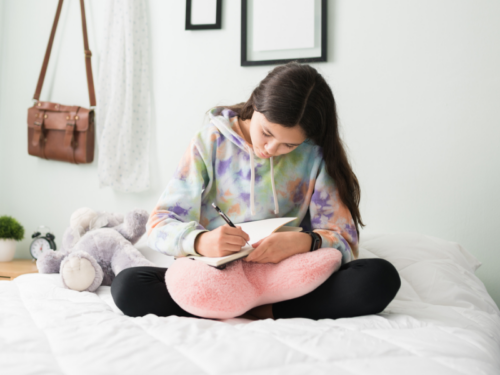
Table of Contents
Try These Therapist-Approved CBT Activities for Teens

Written By: Alex Bachert, MPH

Clinically Reviewed By: Dr. Don Gasparini
February 16, 2024
5 min.
These six activities can help teens and young adults develop coping skills to manage mental health symptoms and build emotional resilience.
Learn more about our Clinical Review Process
Table of Contents
Cognitive behavioral therapy (CBT) is a type of talk therapy that focuses on the connection between our thoughts, feelings, and behaviors. It can be used in individual therapy, family therapy, and group sessions to help people recognize harmful thought patterns and behaviors and replace them with healthier ones.
Since CBT is an action-oriented approach to well-being, therapists will often use therapy activities and interventions to help people overcome their mental health challenges — especially teens and young adults. “CBT provides young people with tools they can grasp earlier in life to assist in navigating interpersonal relationships and various transitions in life,” explained Asha Clark, MS, LPC, a Primary Therapist with Charlie Health. Below, we delve into six therapist-approved CBT activities for teens.
6 therapist-approved CBT activities for teens
As mentioned, CBT often uses activities to help teens and young adults relate to their thoughts, feelings, and behaviors in a more balanced way. “Many times, our interpretation about an event is the cause of suffering, and working through that with the help of your therapist can help to move from pain towards understanding,” explained Clary Figueroa, MSW, a Charlie Health Group Facilitator. The therapist-approved activities below are a good jumping-off point to CBT, but, as Figueroa mentioned, they don’t replace guidance and support from a licensed therapist.
1. Journal
Journaling is a powerful tool for self-reflection, personal growth, and creating positive change. Through structured prompts, CBT journaling helps teens explore their cognitive patterns, emotional experiences, and behavioral responses and the situations that trigger them. “This intervention allows teens to openly express themselves and acquire a healthy coping skill that they can use long after treatment,” said Clark. Here are a few examples of CBT journal prompts:
- Write down a goal you’d like to achieve, and then break it down into smaller, actionable steps.
- Choose a behavior you’d like to better understand and explain the circumstances surrounding it.
- Write down a negative thought and consider what supports or contradicts that thought.
- Record your emotions, noting when they occur, and explore if your thoughts contributed to the emotions.
2. Track your mood
According to Figueroa, CBT can help people develop healthier habits through behavioral activation. “Behavior can directly affect your mood, for better or worse, and it can help us learn how to use skills to put ourselves in situations that will make it most likely to improve our mood,” she explained. Here’s a simple tracking exercise to try at home:
Record your activity for each hour of the day (or as many hours as consistently possible). This means documenting what you were doing, who you were with, etc. Next, rate your mood during each activity. After a set period of time, you can review this information to better understand how you spend your time and how those activities correspond to your mood.
3. Practice mindfulness
Mindfulness is the practice of being fully present and engaged in the current moment without judgment. Research shows that activities such as mindfulness, guided meditation, deep breathing, and body scans can reduce negative thoughts and other mental health symptoms. For teens who are struggling with mental health issues, one of the mindfulness exercises below may be a powerful tool for calming the mind, staying present, and managing stress.
Body scan exercise
Body scanning is a mindfulness practice that helps you observe different parts of the body without judgment. To start, lay down in a comfortable position and focus on your breath. From there, the goal is to bring awareness to different areas of your body, starting with your head and working your way to your toes.

Choose a mindfulness mantra
Some people benefit from focusing on a word or phrase during tough moments. Having a mindfulness mantra, such as “peace” or “let go,” can help reduce stress and keep you feeling centered.
Bring mindfulness to your day-to-day
Whether you’re brushing your teeth, making your bed, or walking to class, make it a point to apply some of the following CBT mindfulness skills throughout the day:
- Focus on the moment without being distracted by other ideas, events, or people
- Participate without being self-conscious
- Adopt a non-judgemental stance
4. Try the “ABCDE model”
“Psychoeducation is the first step in CBT treatment,” according to Clark. One example is the “ABCDE model,” which helps teens recognize and challenge irrational beliefs they have about themselves, the world, and the people around them. Whether it’s self-image, peer relationships, or family issues, therapists can collaborate with youth to identify the following:
- What was the “Activating event” or situation that was the source of your distress?
- What “Beliefs” affected how you responded to the situation?
- What were the “Consequences” of your beliefs?
- How can you “Dispute irrational beliefs”?
- What are “Effective new ways of thinking, feeling, and behaving”?
5. Challenge negative thoughts
Cognitive distortions are irrational or biased ways of thinking that can lead to unhealthy emotions and behaviors. Some examples of cognitive distortions include “black and white” thinking, overgeneralization, emotional reasoning, and catastrophizing (always expecting the worst).
There are several CBT techniques used to challenge negative thoughts, but one idea is to add a “yes, but…” to your sentences. “In this method, you don’t have to ignore or deny your problems to decrease harmful thinking,” said Figueroa. Instead, you “balance thoughts about a difficult situation by adding a more positive or hopeful statement to them.” Here’s an example: Instead of saying, “I am always sad,” try saying, “Yes, I may be sad, but I am working on skills and therapy to help.”

6. Ask worry exploration questions
When something is on our minds, it’s often easy to imagine the worst thing that could possibly happen. But it’s important to remember that what might happen isn’t the same as what will happen.
“Worry exploration questions” are a CBT activity that helps people consider worry versus reality. The following questions were designed to encourage people to explore the most likely outcomes for their worried-about situation.
- What is something you’re worried about?
- What are some clues that your worry won’t come true?
- If your worry doesn’t come true, what will probably happen instead?
- If your worry does come true, how will you handle it? Will you eventually be okay?
- After answering these questions, how has your worry changed?
Cognitive behavioral therapy at Charlie Health
If you or a loved one are struggling with negative thought patterns, anxiety, or other mental health issues, Charlie Health is here to help. Charlie Health offers a virtual Intensive Outpatient Program (IOP) with more than once-weekly mental health treatment for young people and families dealing with complex mental health conditions. Our expert clinicians incorporate a range of evidence-based therapies (including CBT techniques and CBT skills) into individual counseling, family therapy, and group sessions. With support, managing negative thought patterns and mental health challenges is possible. Fill out the form below or give us a call to start healing today.
References
https://www.apa.org/ptsd-guideline/patients-and-families/cognitive-behavioral
https://positive.b-cdn.net/wp-content/uploads/2020/09/Cognitive-Restructuring-Worksheet.pdf
https://www.grouporttherapy.com/blog/cbt-journal-prompts
https://www.therapistaid.com/therapy-worksheet/worry-exploration-questions/cbt/adolescents





